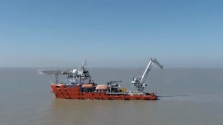
China's self-developed multi-functional modular seabed trencher completed the laying of over 100 kilometers of the first offshore pipeline project in Bangladesh, setting world records in "sea land directional drilling crossing" and "deep-sea trench behind the channel," the China National Petroleum Corporation (CNPC) announced Saturday.
Directional drilling is a technique oil-extraction companies use to access oil in underground reserves. The term deep-sea trench, also known as an oceanic trench, refers to any long, narrow, steep-sided depression in the ocean bottom at depths of approximately 7,300 to more than 11,000 meters.
Usually the depth of the buried offshore pipelines is 1.5 to 3 meters, reaching 5 meters below the seabed, which is already a highly difficult task.
Thanks to China's domestically developed multi-pulse high-power accelerator, "Shenlong-3," the depth reached an unprecedented 11 meters for the 146-kilometer offshore pipeline to go through the sea lanes.
Shenlong-3, the world's first of its kind, is a milestone in developing linear induction accelerators and China's flash radiography technology. The new project will help Bangladesh unload oil from oil tankers of over 100,000 tonnes.
Xuanji Drilling System: A jewel in the crown
In the past few years, China has seen a boom in homegrown technologies and equipment for offshore oil and gas exploration and a rise in investment in financial and human resources in the sector.
With 12 years of experience in the field, China National Offshore Oil Corporation (CNOOC) has developed "Xuanji," a rotary steerable drilling (RSD) and logging-while-drilling (LWD) system for efficient exploration of offshore oil and gas.
According to CNOOC, China's largest offshore oil and gas producer, the Xuanji system can accurately control the drill bit thousands of meters underground to target oil layer and "remotely drive" the drill to stably traverse more than 1,000 meters horizontally or obliquely in the 0.7-meter thin oil layer.
Xuanji can also do real-time analysis of stratigraphic data, helping reduce the financial cost of oil-gas exploration so as to develop more marine oil and gas resources in an economical and efficient manner, said CNOOC.
On April 20 this year, the first intelligent production line of the Xuanji system was put into operation in Foshan City, south China's Guangdong Province, as part of CNOOC's "intelligent manufacturing chain" of high-end oil and gas exploration equipment.
Li Xi'en, a senior technical expert at CNOOC, told China Media Group (CMG) that the company "has adopted a strategy of 'commercializing a generation then developing the next generation' to push forward the domestic research and development of cutting-edge technical equipment."
"Currently, the Xuanji system has covered 32 function modules for three sizes of boreholes. The system's success rate has risen from 79.1 percent to 92 percent since the first test, and its key indicators have reached a global leading level. This year, we have built a production line with an annual output of 100 sets of the Xuanji system along with other high-end technical equipment, formally entering the stage of large-scale industrialization," Li said.
World's first Shenhai-1
Starting with only one platform reaching 100 meters under water, China has been making headways on the path to develop its offshore oil and gas exploration sector. The country now has 61 drilling platforms with an operating water depth exceeding 3,000 meters.
In 2012, six deep-water engineering vessels capable of working at depths of 3,000 meters were put into service, marking China's accelerated development of deep-water oil and gas exploitation equipment.
On June 25, 2021, China's first self-run 100,000-tonne semi-submersible oil and gas production and storage platform, Shenhai-1, started operation in the waters off south China's Hainan Province. By February 13, 2022, it had produced over 1 billion cubic meters of natural gas, said its operator CNOOC.

